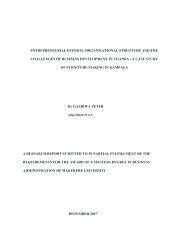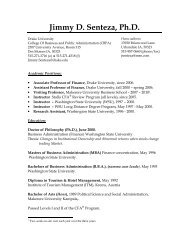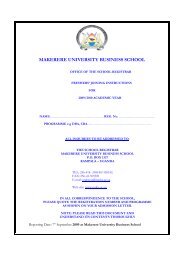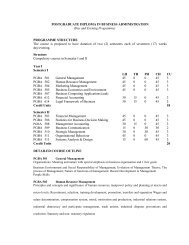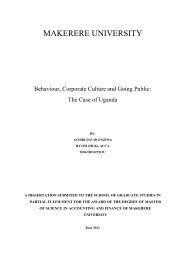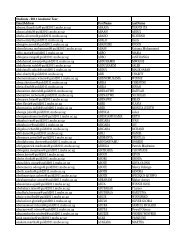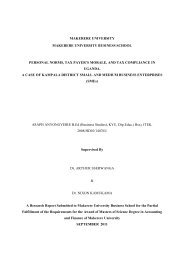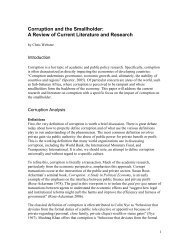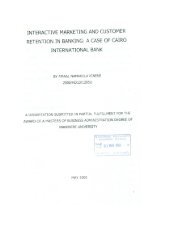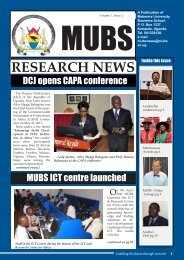13th Annual International Management Conference Proceeding
13th Annual International Management Conference Proceeding
13th Annual International Management Conference Proceeding
Create successful ePaper yourself
Turn your PDF publications into a flip-book with our unique Google optimized e-Paper software.
A production function portrays an important input-output relationship. It describes the rate at which<br />
resources are transformed into products (Doll and Orazem, 1984). Cobb-Douglas production function has<br />
been the most common production function in use.<br />
It provides the following benefits (1) adequate fit if data, though sometimes it may fail hence the need to<br />
perfume model selection tests before endorsing the use of the model (2) computational feasibility and (3)<br />
sufficient degrees of freedom are used to allow for statistical testing. Due to these numerous advantages of<br />
the Cobb- Douglas type of production function, it has been widely used in agricultural studies and in this<br />
study.<br />
The major shortcomings have been identified as, mis-specification, input measurements and multicollinearity.<br />
These have led to unreliable biased results in most cases and have necessitated precautionary<br />
measures for reliable results to be achieved.<br />
Multicollinearity and the Cobb-Douglas production function<br />
The Cobb-Douglas production function estimated by least squares method has been widely applied in<br />
agriculture, but estimates based on cross sectional samples of farms, most typical elasticities of labour and<br />
land are negative. These negative coefficients have been attributed to the existence of multicollinearity in<br />
random sample or non-stratified farm samples where farms with large labour inputs are also those with larger<br />
inputs of land and various forms of capital (Roy et al. 1975). In addition, reporting or measuring bias and<br />
other inadequacies of labour have been similarly attributed to the cause of multicollinearity. Doll (1974)<br />
confirms that modern theory suggests that multicollinearity may lead to problems of structural estimation<br />
and specification errors.<br />
Many studies have proposed ways of minimizing the effect of multicollnearity. Heady (1968) cited many<br />
ways like combining variables in the same units, developing an index of sets of related variables through use<br />
of principle component analysis and inserting the index into the regression as a proxy for the original<br />
variable. However, Doll (1974), noted that if inputs are not perfectly correlated no aggregation is needed.<br />
Similarly, many others have proposed aggregation as one of the ways of overcoming multicollinearity within<br />
variables. Unfortunately, there has not been any standard way of aggregating inputs and consequently Earl<br />
(1961) realized that a high degree of aggregation may imply that the resultant function may be of little<br />
relevance in decision-making. Though aggregation serves the purpose, the categorization should depend on<br />
the investigator’s assessment of the strategic inputs in the production process. Faced with these constraints, it<br />
is important to dwell on the procedures for input use and measurement while applying the Cobb-Douglas<br />
type production function.<br />
To be able to counteract the problem of muliti-collinearity in this study a procedure of aggregating inputs,<br />
which have the same measurement unit, was adopted. For instance all tools and equipment were grouped into<br />
one variable. Family and hired were assumed to be homogenous and so were represented by a proxy for total<br />
labour measured in person-days. During data analysis a test for collineraity among all the independent<br />
variables was done and variables were found to have very weak relationships.<br />
Input use and measurement<br />
Labour use measurement<br />
Many methods of estimating the cost of labour have been put forward. Krause (1982) gave an alternative of<br />
adding up family and hired labour then multiply by the average area wage rate and length of time required<br />
for all operations. Considering that hired labour becomes a purchased input the wage rate represents the unit<br />
cost as stated by Martin (1973). Mahmood et al. (1979) suggested that the wage rate for family labour<br />
obviously must be an imputed rate, and the imputation used was that chosen by the respondents. Therefore,<br />
this study considered average area wage rate as the labour cost per person-day.<br />
Land use measurement<br />
Heady et al. (1969) notes that the major difficulties in measuring land are so inflexible not like in measuring<br />
labour and capital. For example, differences in land quality are likely to be indicated by the market value. In<br />
74



